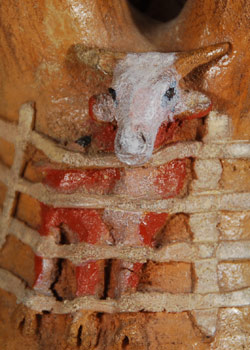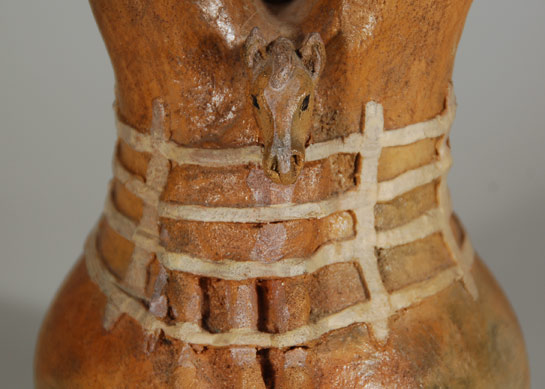Diné (Navajo) Wedding Vessel with Appliqué Design of a Cow and Horse [SOLD]
+ Add to my watchlist Forward to Friend
- Category: Modern
- Origin: Diné of the Navajo Nation
- Medium: clay, pigment
- Size: 7” tall x 4-1/2” diameter
- Item # 25605 SOLD
 Silas and Bertha Claw broke with Navajo pottery tradition and the customs of their fellow tradesmen. Their forms remained true to tradition but they used an appliqué technique for design elements and colorful oil or acrylic paints for highlights. They were of the Shonto/Cow Springs region of the Navajo Reservation. Silas passed away in 2002 but we have found no record of Bertha passing away.
Silas and Bertha Claw broke with Navajo pottery tradition and the customs of their fellow tradesmen. Their forms remained true to tradition but they used an appliqué technique for design elements and colorful oil or acrylic paints for highlights. They were of the Shonto/Cow Springs region of the Navajo Reservation. Silas passed away in 2002 but we have found no record of Bertha passing away.
Around 1968, Silas began working in clay even though pottery making, like basket making, was considered women's work. Bertha assisted him from the very beginning. The Claws made a variety of pottery shapes: traditional-style cooking jars, wedding vases, triple-spouted jars, and ceramic beads.
 It is not known which one did which part of the production but it is believed Bertha would form the vessels and Silas would decorate them with a variety of appliquéd and incised plant and animal motifs—usually in high relief and occasionally in full round. These motifs depicted a wide range of subjects that included cactus plants and blooming yuccas, oak leaves with acorns, ears of corn, a menagerie of domestic animals, and horned toads. Silas often applied oil paint in a range of colors to portions of the appliqués to make them even more realistic. He then would coat the vessel with varnish.
It is not known which one did which part of the production but it is believed Bertha would form the vessels and Silas would decorate them with a variety of appliquéd and incised plant and animal motifs—usually in high relief and occasionally in full round. These motifs depicted a wide range of subjects that included cactus plants and blooming yuccas, oak leaves with acorns, ears of corn, a menagerie of domestic animals, and horned toads. Silas often applied oil paint in a range of colors to portions of the appliqués to make them even more realistic. He then would coat the vessel with varnish.
This wedding vessel has a horse on one side and a cow on the opposing side, both of which are fenced into a corral. Interestingly, each animal has three legs visible but it is assumed that the fourth leg of each is behind one of the others. The vessel was coated in varnish after completion and signed on the underside with the joint signature S. B. Claw.
Condition: original condition
Provenance: from the collection of Chuck and Jan Rosenak, renowned collectors and authors of Navajo Folk Art.
Recommended Reading:
- Navajo Folk Art: The People Speak by Chuck and Jan Rosenak.
- The Navajo Pottery of Silas and Bertha Claw by Ed Dobbins and Scott C. Russell, American Indian Art Magazine, Spring 2007. Vol. 32, No. 2.

- Category: Modern
- Origin: Diné of the Navajo Nation
- Medium: clay, pigment
- Size: 7” tall x 4-1/2” diameter
- Item # 25605 SOLD



